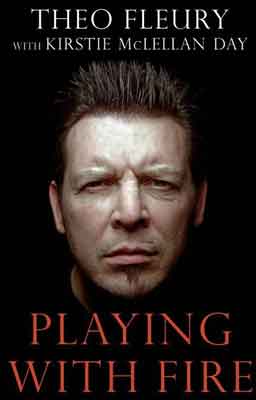 Theo Fleury’s autobiography Playing with Fire is as direct and hard hitting as his play was on the ice.
Theo Fleury’s autobiography Playing with Fire is as direct and hard hitting as his play was on the ice.
That shouldn’t surprise anyone who followed the National Hockey League in the 1990s. Fleury was known as much for his energetic style and dynamic playing-making ability as his knack for pissing people off and getting in to trouble both in the arena and in real life.
Playing with Fire is Fleury’s memoir and confessional where he brings every imaginable skeleton out of his closet for all to see.
It’s a dark, often depressing look at his life on and off the ice. The turning point of the book comes early, when Fleury attends Andy Murray’s hockey camp and meets the scout and junior hockey coach Graham James, infamous for being convicted of the molestation of NHLer Sheldon Kennedy.
Of course, when the 13-year-old Fleury attended the camp, James’ dark second life wasn’t public knowledge and, according to the book, the vulnerable kid from Russel, Manitoba soon fell victim along with his friend Kennedy.
This revelation is what grabbed all the headlines when Playing with Fire was first published in 2009 and it is the central issue of the entire autobiography. All of Fleury’s behaviour afterwards is a reaction to the alleged abuse, either to distract himself from the guilt and pain of James’ assault or because he’s lashing out in anger.
Playing with Fire therefore serves as Fleury’s confessional, as he tries to explain his behaviour for most of his adult life and also tries to apologize to the many people he hurt or wronged, including teammates like Craig Conroy and Robyn Regher but especially his children Josh, Beaux and Tatym.
In many respects, reading Playing with Fire reminded me of professional wrestler Bret Hart’s autobiography Hitman. Both are athletes with deep connections to Alberta and Calgary, both are known for their incredible skills and both have a variety of personal problems stemming from abuses suffered while they were kids.
However, there are still differences. Hart is undoubtedly the better writer, but Fleury is the more genuine author. Hart is shockingly cavalier about the sex, drugs and violence in his professional and personal life, while Fleury is remorseful and regrets most of his behaviour.
Although this makes Playing with Fire less entertaining than Hitman, it’s also more emotionally fulfilling. The lows may be lower in Fleury’s narrative, but the highs are also higher.
Hart comes across as a bitter old man by the end of his book, while Fleury is clearly a happier, healthier person hoping to give back to society through his book, public speaking and charitable works.
Playing with Fire is definitely worth a read. Not just for hockey fans who want to read all about Theo Fleury’s wild stories, but for its value as a cautionary tale for any parents considering getting their child involved in amateur hockey.
I haven’t posted on here since my lengthy post on Chris Bosh’s place in the history of Toronto’s sports teams. That was on Feb. 11th, the day of Bosh’s return to the once-friendly confines of the Air Canada Centre.
It was also a lifetime ago in the world of blogging.
My paid work for the Canadian Press has taken precedent over my blog work. That’s just the way it’s got to be. After all, this lifestyle doesn’t pay for itself.
In any event, things should be picking up on this page. I’ve got a review of Bob Sirois’ controversial Discrimination in the NHL and I just finished Theo Fleury’s memoir Playing with Fire. Both were fascinating looks at life in professional hockey, and I’ll have posts on both of them shortly.
In the long run, I should be going back to working nights and some of the junior hockey beat. I’ll keep all of you posted, but things should be returning to normal in this space.
Welcome back!
